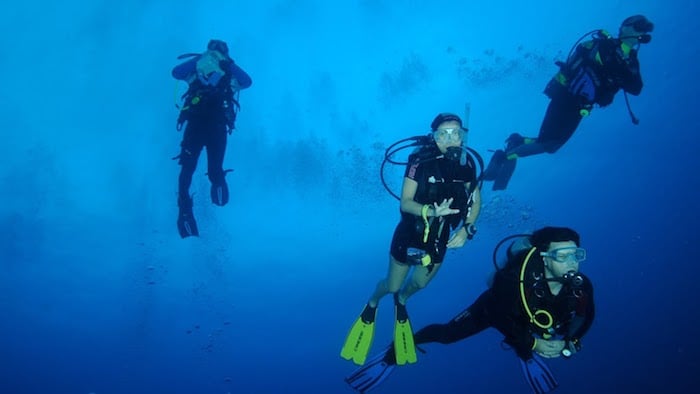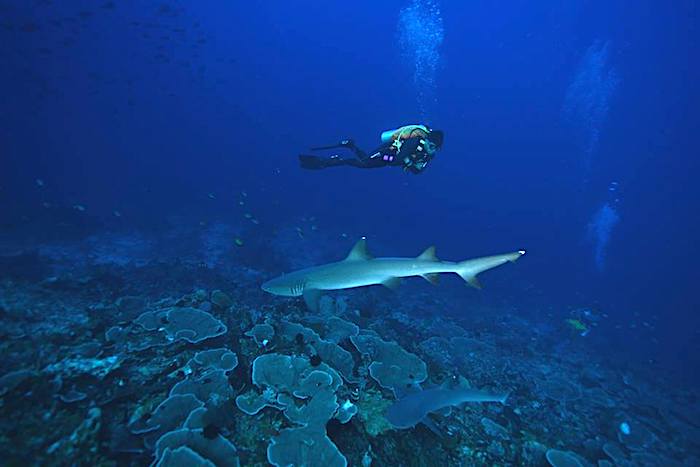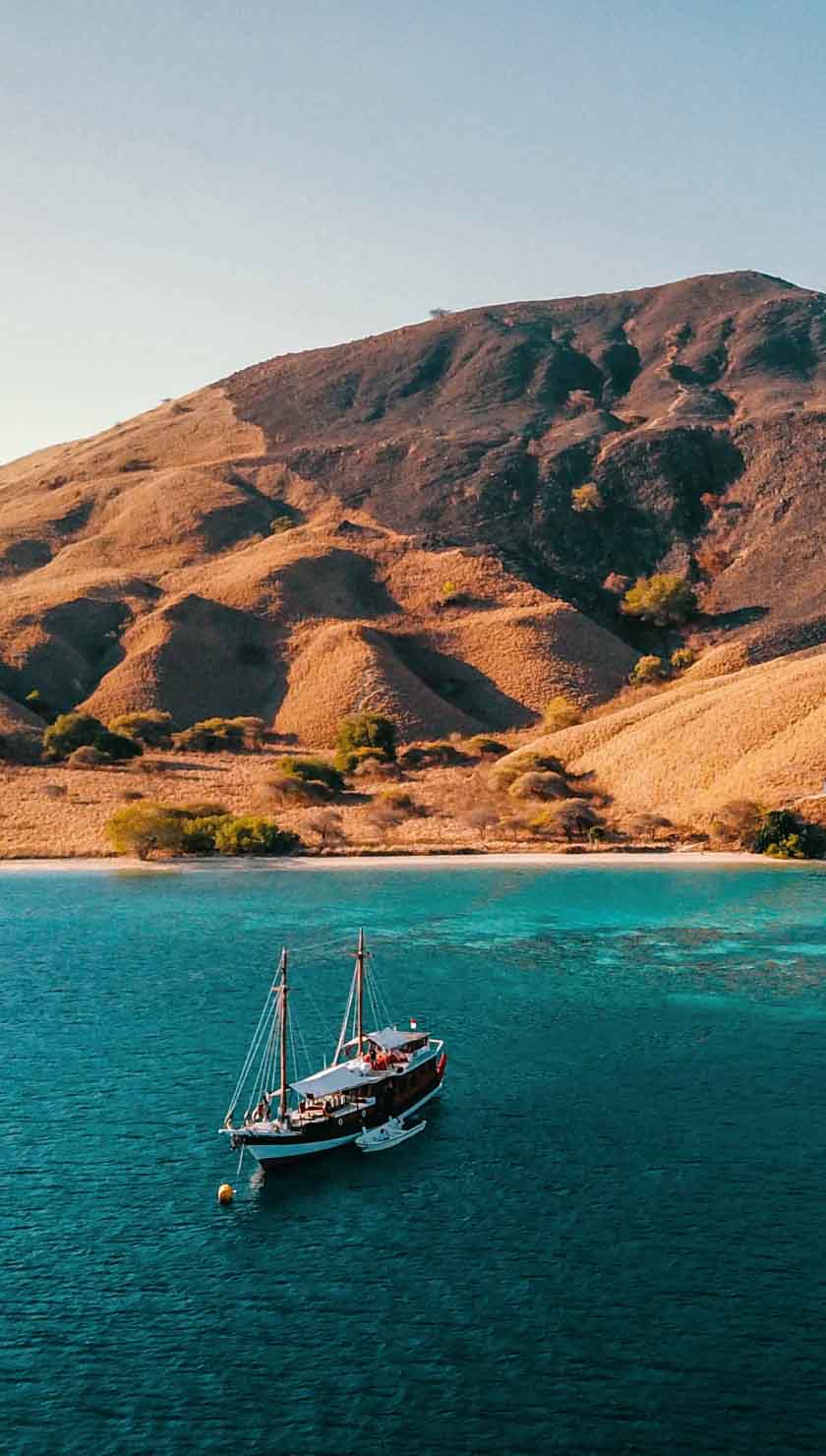Grundlagen des Strömungstauchens

Was ist Strömungstauchen?
Drift Diving ist eine Art des Tauchens, bei der der Taucher die Strömung nutzt, um entlangzutreiben und ein Tauchgebiet zu genießen, anstatt seine Flossenkraft einzusetzen, um voranzukommen.
Warum Strömungstauchen?
Drifttauchen kann entspannend sein und je nach Tauchkonditionen eine der aufregendsten Arten des Tauchens. Eine gleichmäßige Strömung kann einen Taucher ohne großen Aufwand mittragen, und es ist eine großartige Möglichkeit, im Einklang mit der Strömung die Unterwasserlandschaft zu genießen. Andererseits kann eine starke Strömung dem Taucher das wahre Gefühl geben, unter Wasser zu fliegen, während er mit der Strömung treibt.
Das Drifttauchen ermöglicht es Tauchern, ein großes Gebiet abzudecken, da sie schneller mit der Strömung gleiten, als wenn sie mit Flossenbewegung vorankommen würden. Die Strömungen an Drifttauchplätzen transportieren kontinuierlich Nährstoffe und ziehen oft größere pelagische Lebewesen an. Dies schafft Biodiversitätshotspots, in denen Taucher eine Vielzahl von Meereslebewesen genießen können, einschließlich Gruppen von Haien und anderen großen Meeresarten.
Wo kann man Strömungstauchen gehen?
Drift-Tauchmöglichkeiten gibt es weltweit und bieten die Chance, das Drift-Tauchen zu jeder Jahreszeit zu erleben.
Beste Drift-Tauchplätze in Ägypten
Ägypten ist bekannt für farbenfrohes Tauchen und bietet zahlreiche Tauchplätze, die das ganze Jahr über erkundet werden können.
Shark und Yolanda Reef ist ein bekannter Tauchplatz im Ras Mohammed Nationalpark , der bunte Korallen, große Fischschwärme, Rochen und Rotfeuerfische sowie einen Drift-Tauchgang zwischen zwei Korallenriffen bietet. Die Strömungen am Shark und Yolanda Reef können ziemlich stark sein, was diesen Tauchplatz ideal für fortgeschrittene Taucher macht, die Drift-Tauchen ausprobieren möchten, ohne sich zu sehr auf starke Strömungen einzulassen.
Elphinstone ist eine beliebte Tauchregion in Ägypten mit Strömungen und Steilwänden, die sich für erfahrenere Taucher eignen. Die Wände am Elphinstone fallen steil ab und sind von harten und weichen Korallen bedeckt. Die Strömung verläuft normalerweise von Norden nach Süden entlang der Wände und erreicht Drift-Tauchgeschwindigkeiten von bis zu 2 Knoten. Elphinstone ist bekannt für Begegnungen mit ozeanischen Weißspitzenhaien, aber auch Fuchshaie, Walhaie und Hammerhaie werden gesichtet. Es gibt zahlreiche Riff-Fische, riesige Napoleon-Lippfische und Barrakudas.
Daedalus Riff bietet einige der besten Tauchmöglichkeiten im Roten Meer und liegt in einer maritim geschützten Zone westlich von Marsa Alam, einem ruhigen Ferienort. Dieses abgelegene Riff hat starke Strömungen und ist unberührt, mit vielen Riff-Fischen und großen pelagischen Arten. Es gibt steile Abhänge zu bestaunen, und mehrere Drift-Tauchgänge sind am Daedalus möglich. Das Tauchen ist am besten für erfahrene und technische Taucher geeignet.
In Ägypten gibt es viele Tauchplätze, die für Anfänger und erfahrene Taucher geeignet sind, was es zu einem idealen Ziel für Taucher aller Erfahrungsstufen macht. Es gibt mehrere Ägypten-Liveaboard-Tauchschiffe , von denen aus Sie das Rotmeer-Tauchen erleben können. Die Emperor Asmaa und die Red Sea Aggressor II bieten Routen zur Erkundung des südlichen Roten Meeres, einschließlich des Daedalus Riffs.
Beste Drift-Tauchplätze auf den Galapagos
Die Galapagos-Inseln stehen bei vielen Tauchern auf der Wunschliste und bieten einige der besten Tauchmöglichkeiten der Welt. Die Inseln beheimaten zahlreiche endemische Arten, zahlreiche Haie und andere große pelagische Lebewesen. Taucher können Meerechsen, Seelöwen, Pinguine, Hammerhaie, Galapagos-Haie und Mola mola erleben.
Die starken Strömungen an den Inseln bieten aufregendes Tauchen, insbesondere an den Wolf und Darwin Inseln. Diese sind die abgelegensten der Galapagos-Inseln, und die Strömungen können dort sehr stark sein, daher sollten Taucher auf negative Einstiege, Handschuhe und die Notwendigkeit vorbereitet sein, sich manchmal an Felsen festzuhalten.
Das Drift-Tauchen auf den Galapagos-Inseln ist am besten für erfahrene Taucher geeignet. Einige Tauchplätze sind jedoch auch für neue Taucher geeignet und bieten ruhige und flache Bedingungen für entspannte Tauchgänge. Es gibt eine kleine Anzahl von Galapagos-Liveaboard-Tauchschiffen zur Auswahl. Die Galapagos Master bietet 7- bis 10-Nächte-Tauchsafaris an.
Beste Drift-Tauchplätze in Mikronesien
Mikronesien ist ein erstklassiges Tauchziel, bekannt für lebhafte Korallengärten, steile Wände, Abhänge und zahlreiche Wracks aus dem Ersten und Zweiten Weltkrieg. Tauchen in Palau bietet aufregendes Drift-Tauchen.
Ulong Channel in Palau ist nichts für schwache Nerven. Das Tempo dieses Tauchgangs ist enorm und führt Taucher in einen Kanal, um einen der besten Drift-Tauchgänge der Welt zu erleben. Der Eingang des Kanals ist von Korallen bedeckt, und Taucher driften durch den Kanal zum Ausgang, wo graue Riffhaie beim Jagen von Fischen zu sehen sind, die den Kanal verlassen. Auch Stachelrochen, Schnapper, Jacks und Fledermausfische sind am Kanalmund zu beobachten.
Reef Hooks sind nötig, um sich vor Beginn der Strömung an der Wand zu verankern, bevor die Strömung die Taucher zu weit zieht. Die Strömungen können unvorhersehbar und stark sein und manchmal mitten im Tauchgang die Richtung ändern. Dieser Platz sollte bei auflaufender Flut für die stärkste Strömung dived werden.
Blue Corner in Palau ist besonders beliebt, und das zu Recht. Dies ist ein Wandtauchgang mit starker Strömung, was ihn ideal für Drift-Tauchen macht. Die Strömung zieht Taucher entlang der Wand, um graue und Weißspitzen-Riffhaie, Makrelen, Thunfische, Schildkröten und Adlerrochen zu genießen.
Das Drift-Tauchen in Mikronesien ist am besten für erfahrene Taucher geeignet, und für einige Drift-Tauchgänge sind Reef Hooks notwendig. Es gibt eine kleine Anzahl von Liveaboards für das Tauchen mit Liveaboard in Palau, darunter die wunderschöne Palau Siren Yacht, die 7- bis 10-Nächte-Palau-Tauchsafaris anbietet.
Beste Drift-Tauchplätze auf den Malediven
Scuba-Tauchen auf den Malediven ist gleichbedeutend mit weißen Sandstränden, Korallenriffen, klarem, warmem Wasser und Tauchplätzen voller Meereslebewesen. Die Malediven bieten einige der besten Tauchplätze der Welt und sind auch ein großartiges Ziel für Drift-Tauchen.
Noonu-Atoll , eines der nördlichen Atolle, bietet aufregende Tauchgänge, wie zum Beispiel Orimas Thilaat. Der Abstieg an diesem Tauchplatz führt zu einem sandigen Kanal in 30 Metern (98 Fuß) und dann zu einer Haiputzstation. Die Strömungen um Noonu können mehr als 2 Knoten erreichen, und die Gegend ist bekannt für graue Riffhaie, Adlerrochen und zahlreiche Riff-Fische.
Ari-Atoll bietet ein anderes Erlebnis als die meisten Taucheräume auf den Malediven, da es nicht durch lange Riffstrecken gekennzeichnet ist. Stattdessen taucht man rund um Thilas (unterseeische Inseln), Kandu (Kanäle) und Lagunen. Fast alle Tauchgänge in diesem Gebiet sind Drift-Tauchgänge, und die Strömungen sind stark. Die Strömungen am Ari-Atoll sind ideal für Begegnungen mit kleinen und großen Meeresbewohnern. Es gibt viele Tauchplätze, die Nacktschnecken, Kriechtiere, Schildkröten, Riffhaie, Hammerhaie, Mantarochen, Adlerrochen und Walhaie bieten.
Einer der besten Tauchplätze auf den Malediven, Mushi Mas Mingle Thia , befindet sich im Ari-Atoll. Taucher können Gruppen von grauen Riffhaien, Weißspitzenriffhaien, Jacks, Thunfischen und Napoleon-Lippfischen sehen. Wer Walhaie und einen Drift-Tauchgang erleben möchte, sollte Maamigili Beru im südlichen Teil des Ari-Atolls besuchen. Die gleichmäßige Strömung führt Taucher an Riffen und Sandflächen vorbei und ist kein starker Drift-Tauchgang. Junge Walhaie sind hier das ganze Jahr über zu sehen.
Das Tauchen am Ari-Atoll ist am besten für erfahrene Taucher geeignet, obwohl es auch Tauchplätze für weniger erfahrene Taucher gibt. Zahlreiche Malediven-Liveaboards sind für alle Budgets und unterschiedliche Safari-Dauern verfügbar.
Beste Drift-Tauchplätze in Komodo
Komodo ist einer der artenreichsten Orte in Indonesien und bietet Wandtauchgänge, Pinnacles, Seeberge, flache Riffe und Durchgänge, die nur darauf warten, erkundet zu werden. Die Strömungen in Komodo sind sehr stark und bieten fantastische Möglichkeiten zum Drift-Tauchen. Taucher werden wahrscheinlich Wale, Delfine, Mantarochen, Haie, zahlreiche Kleintiere und Riff-Fische sehen.

Batu Balong ist ein riesiger Pinnacle-Wandtauchgang mit außergewöhnlich schnellen Strömungen. An diesem Tauchplatz können Taucher Napoleon-Lippfische, ozeanische Weißspitzenhaie und zahlreiche Riff-Fische beobachten.
Aufgrund der starken Strömungen in der Region ist das Tauchen in Komodo am besten für fortgeschrittene oder erfahrene Taucher geeignet. Zahlreiche Komodo-Liveaboard-Tauchsafaribooten stehen zur Verfügung.
Beste Drift-Tauchplätze in Französisch-Polynesien
Das Tuamotu-Archipel ist das Hauptziel für luxuriöses Polynesien-Liveaboard-Tauchen . Es bietet Tauchmöglichkeiten in zwei bekannten Gebieten: den Atollen Rangiroa und Fakarava.
Einige Liveaboards verbringen ihr gesamtes Programm am atemberaubenden Fakarava-Atoll , das unberührtes Tauchen bietet. Am südlichen Ende des Atolls können Taucher den Tumakohua-Pass erleben. Dieser schmale Kanal führt in die Lagune des Atolls, und die Wasserströmungen im Kanal erreichen bei auflaufender Flut Geschwindigkeiten von bis zu 4 Knoten. Taucher starten im offenen Ozean und schwimmen zum Kanaleingang, um die Shark Wall zu sehen. Hunderte von grauen, Schwarzspitzen- und Weißspitzenriffhaien versammeln sich am Eingang des Kanals. Einmal im Pass, werden die Taucher an korallenbedeckten Wänden und zahlreichen Fischen vorbeigeführt, bevor sie ihren Tauchgang in der Lagune beenden.
In Fakarava gibt es zahlreiche weitere Tauchgänge, darunter Manta-Putzstationen und flache Rifftauchgänge mit gesundem Hartkorallenbewuchs.
Das Rangiroa-Atoll ist mit 170 Quadratkilometern eines der größten Atolle der Welt, und der Tiputa-Pass ist ein polynesisches Tauch-Highlight. Dieser Kanal wird bei einlaufender Flut von einer starken Strömung umspült und bietet die Möglichkeit, mit riesigen Schulen von Grauen Riffhaien, Mantas, Rifffischen, Großen Tümmlern und gelegentlich Tigerhaien zu tauchen.
Tauchsafaris in Polynesien eignen sich für Taucher verschiedener Erfahrungsstufen, und nur wenige ausgewählte Safariboote fahren dieses weit entfernte Paradies an. Die French Polynesia Master bietet Tauchgänge im gesamten Tuamotu-Archipel an und ist für bis zu 25 Personen ausgelegt. Der Katamaran Aqua Tiki II bietet intime Tauchsafaris in Französisch-Polynesien für bis zu 8 Gäste.
Bestes Strömungstauchen auf den Bahamas
Die Washing Machine ist ein Tauchplatz in den Exuma Cays mit einer starken kreisförmigen Strömung, die Taucher kopfüber dreht, als wären sie in einer Waschmaschine. Die Strömung ist nur in einem bestimmten Bereich und kann leicht vermieden werden. Die Strömung bringt Taucher auf eine Tiefe von 12 Metern (40 Fuß) und hebt sie dann auf 5 Meter (15 Fuß) auf ein Stück Riff. Das Riff beherbergt zahlreiche tropische Fischarten, Fledermausfische und eine Vielzahl von Korallen. Auch Meeresschildkröten und Ammenhaie sind in diesem Gebiet zu finden. Es gibt zahlreiche andere Bahamas-Tauchplätze zu genießen, und das Tauchen auf den Bahamas ist für alle Erfahrungsstufen geeignet. Vorherige Drift-Taucherfahrung ist hilfreich, aber nicht erforderlich. Es gibt eine Handvoll
Wann man Strömungstauchen geht
Das Rote Meer kann das ganze Jahr über betaucht werden, und die Planktonblüte in Elphinstone von Mai bis Juli zieht Walhaie, Mantas und Schildkröten an. Hammerhaie werden im Sommer häufiger in Elphinstone gesichtet, während Fuchshaie im Winter vorbeischauen.
Tauchen in den Galapagos-Inseln ist das ganze Jahr über möglich, mit zwei Hauptsaisons. Die Regenzeit von Januar bis Juni bietet wärmeres Wasser, wobei Januar bis Mai eine gute Zeit ist, um Mantas und Hammerhaie zu sehen. Die Trockenzeit ist in der Regel belebter und bietet die Chance, Walhaie zu sehen.
Die beste Zeit für einen Besuch in Palau, Mikronesien, ist von November bis Mai, obwohl man das ganze Jahr über tauchen kann.
Tauchen auf den Malediven ist das ganze Jahr über möglich, es gibt jedoch zwei Saisons. Von Dezember bis Mai bietet der Nordost-Monsun die ruhigsten Gewässer mit der besten Sicht auf der östlichen Seite. Der Südwest-Monsun spiegelt die Bedingungen des Nordost-Monsuns wider und bringt bewölkteres Wetter und weniger ruhige Meere. Das Ari-Atoll kann am besten von Januar bis April wegen der ruhigen Meere und der Chance, Mantas und Walhaie zu sehen, betaucht werden. Es kann jedoch auch zu anderen Zeiten im Jahr getaucht werden. Tauchen am Noonu Atoll ist das ganze Jahr über möglich, aber die beste Zeit dafür ist von Januar bis Mai.
Komodo kann das ganze Jahr über betaucht werden, wobei die Trockenzeit das beste Wetter und die ruhigsten Gewässer bringt. Die Trockenzeit dauert von April bis November, und die beste Tauchsaison ist von April bis August. Mantarochen können das ganze Jahr über gesichtet werden, jedoch häufiger von Dezember bis Februar, während Mola Mola am ehesten im August gesehen wird.
Tauchen in Französisch-Polynesien ist das ganze Jahr über möglich, obwohl Januar bis März die wärmsten (und feuchtesten) Monate sind. Buckelwale können in den kühleren Monaten beobachtet werden, und Marmorgroupers können im Juni und Juli beim Laichen gesehen werden.
Die Bahamas lassen sich am besten während der Trockenzeit von November bis Mai betauchen, obwohl es im ganzen Jahr möglich ist. Februar und März sind gute Monate, um Bullen- und Tigerhaie zu sehen, und die Exuma Cays können das ganze Jahr über betaucht werden.
Welche Meereslebewesen kann man beim Strömungstauchen sehen?
Das Meeresleben, das beim Strömungstauchen zu sehen ist, hängt vom Tauchort ab, aber die starken Strömungen, die mit dem Strömungstauchen verbunden sind, ziehen typischerweise große Tiere an, wie etwa Schulen von Haien und Rochen. Der obige Reiseführer bietet weitere Details zu den Höhepunkten der Meereslebewesen.
Wer kann Drift-Tauchen ausprobieren?
Jeder Taucher kann Drift-Tauchen ausprobieren, obwohl viele Drift-Tauchgänge nur für Taucher mit Vorerfahrung geeignet sind. Ausbildungseinrichtungen für Taucher bieten Drift-Taucher-Kurse an, die exzellente Techniken für das Drift-Tauchen sowie Ausrüstungsüberlegungen für diejenigen bieten, die Drift-Tauchen ausprobieren möchten.
Welche Ausrüstung brauchen Taucher für das Strömungstauchen?
Riffelhaken und Handschuhe sind nützlich für das Strömungstauchen, wenn Taucher sich während eines Strömungstauchgangs verankern oder anhalten müssen. Eine Signalboje ist erforderlich, um die Positionen der Taucher hervorzuheben, insbesondere beim Auftauchen, da Strömungen Taucher zu verschiedenen Ausstiegspunkten treiben können. Eine Trillerpfeife ist ebenfalls hilfreich, wenn ein Taucher weit vom Boot entfernt auftaucht.
Welche Tauchfertigkeiten brauchen Strömungstaucher?
Taucher sollten ihre Tauchausrüstung optimieren, um zu verhindern, dass lose Ausrüstung durch starke Strömungen verheddert oder weggezogen wird. Sie sollten sich jederzeit der Strömungen bewusst sein und auf neutrale Tarierung achten, um Kollisionen während eines Strömungstauchgangs zu vermeiden. Außerdem sollten sie in der Nähe des Tauchführers bleiben und dessen Anweisungen während des Strömungstauchens folgen.
Was sind die Hauptgefahren beim Strömungstauchen?
Die Hauptgefahr beim Strömungstauchen besteht darin, von einer starken Strömung von der Tauchgruppe weggetrieben zu werden. Dieses Risiko kann minimiert werden, indem man den Tauchanweisungen folgt, sich mit dem Tauchplatz vertraut macht und gut innerhalb des eigenen Erfahrungsniveaus taucht.










